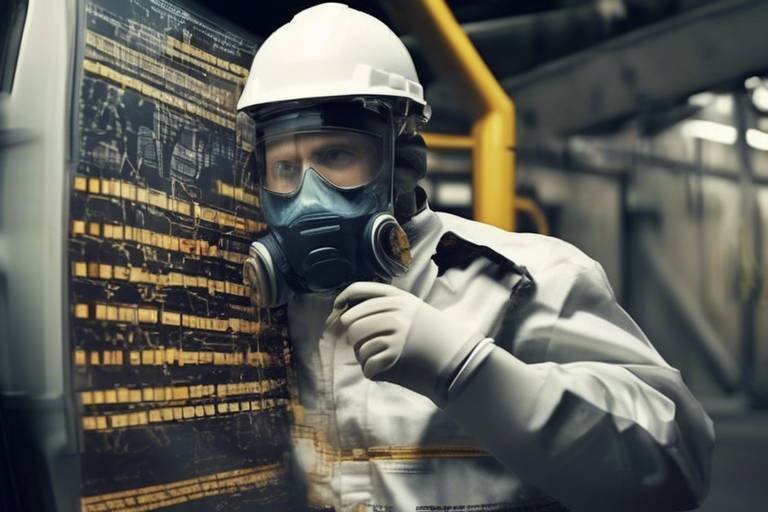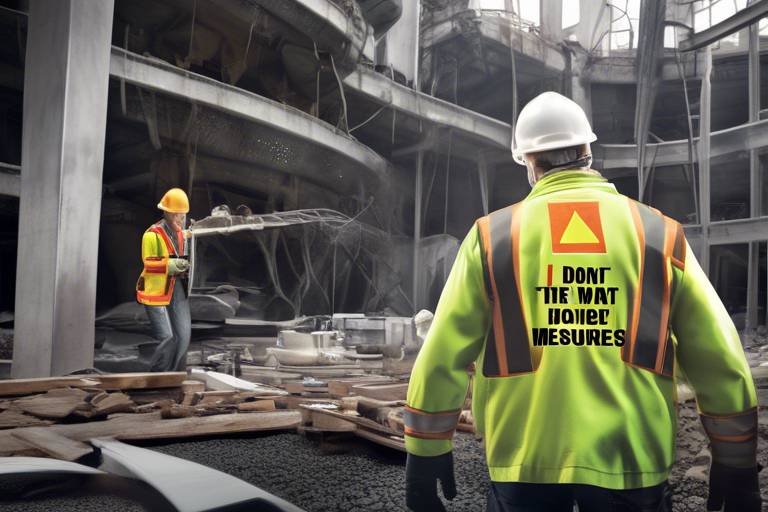Human Behavior: An Unseen Factor Influencing Safety Measures
When we think about safety measures, we often envision strict protocols, regulations, and high-tech equipment designed to protect us. However, there's an invisible force at play that can significantly affect the effectiveness of these measures: human behavior. It's fascinating to consider how our thoughts, emotions, and social interactions can either bolster or undermine safety practices. In this article, we will dive deep into the psychological aspects of human behavior that influence safety measures across various environments—from workplaces to public spaces. Understanding this intricate relationship is not just an academic exercise; it’s essential for developing more effective safety protocols and fostering a culture of safety that resonates with everyone involved.
Understanding how individuals perceive risks is crucial for developing effective safety measures. Risk perception is not merely a rational evaluation of danger; it’s heavily influenced by cognitive biases and emotional responses. For instance, people often underestimate risks that are not immediately visible or that they have not personally experienced. This can lead to a false sense of security, where individuals might engage in unsafe behaviors simply because they don't perceive the risk as significant.
Cognitive biases, such as the optimism bias, can make individuals believe that negative outcomes are less likely to happen to them compared to others. This can lead to a dangerous mindset where safety protocols are ignored. Moreover, emotional responses can create a disconnect between knowledge and action. For example, fear can paralyze decision-making, while overconfidence can lead to reckless behavior. By understanding these psychological factors, organizations can tailor their safety measures to address these biases, ensuring that individuals recognize and respond appropriately to risks.
Cultural norms and values shape how individuals approach safety. In some cultures, compliance with safety measures is viewed as a collective responsibility, while in others, individual freedom may take precedence. This cultural context plays a significant role in determining safety practices and compliance among different groups. For instance, in cultures where hierarchy and authority are respected, individuals might be more likely to follow safety protocols if they are mandated by leadership. Conversely, in more egalitarian cultures, peer influence and group consensus might drive adherence to safety measures.
Social norms can compel individuals to adhere to or disregard safety measures. In many settings, especially workplaces, peer pressure can be a double-edged sword. On one hand, a strong safety culture can encourage employees to prioritize safety, while on the other hand, the desire to fit in can lead to risky behaviors. For example, if a group of coworkers routinely skips safety gear because “everyone else is doing it,” an individual might feel pressured to conform, even if they know it’s unsafe.
This tension between individual accountability and collective safety responsibilities is crucial in understanding safety outcomes. While it’s essential for individuals to take personal responsibility for their safety, the collective attitude of a group can significantly impact overall safety compliance. When individuals feel that they are part of a team that values safety, they are more likely to engage in safe behaviors. Conversely, if safety is seen as a personal issue rather than a shared responsibility, compliance can suffer.
Effective strategies for motivating individuals to prioritize safety are essential. Organizations can implement various approaches to foster a culture of safety, including:
- Incentives: Offering rewards for safe behavior can encourage individuals to adhere to safety protocols.
- Education: Providing training and resources can empower individuals to understand the importance of safety measures.
- Awareness campaigns: Regular reminders and discussions about safety can keep it top-of-mind for everyone.
By creating an environment where safety is prioritized and valued, organizations can motivate individuals to adopt safer behaviors.
Cognitive dissonance can lead to conflicts between beliefs and actions regarding safety. For example, a worker may believe that safety is important but still engage in unsafe practices due to peer pressure or a desire to complete tasks quickly. Addressing these conflicts is vital for enhancing compliance with safety protocols. Organizations can help individuals reconcile these differences by promoting open discussions about safety concerns and encouraging a culture where speaking up is valued.
Stress can significantly affect decision-making processes related to safety. In high-stress environments, individuals may act impulsively or overlook safety measures, leading to potential accidents. Stress can cloud judgment, making it difficult for individuals to assess risk accurately. Understanding the impact of stress on behavior is crucial for developing safety measures that account for these psychological factors.
Implementing stress management techniques can improve safety outcomes. Organizations can provide training on various methods to help individuals cope with stress in high-risk situations. Techniques such as mindfulness, breathing exercises, and regular breaks can help reduce stress levels and improve focus, ultimately leading to better safety decisions.
Leadership plays a pivotal role in establishing and maintaining a safety culture. Leaders set the tone for safety within organizations, influencing behaviors, attitudes, and overall safety perceptions. When leaders prioritize safety and model safe behaviors, it creates an environment where employees feel empowered to do the same. This top-down approach can help build a culture of safety that permeates every level of the organization.
- How does human behavior affect safety measures?
Human behavior influences how individuals perceive risks, comply with safety protocols, and respond to stress, ultimately impacting overall safety outcomes. - What role does culture play in safety behavior?
Cultural norms and values shape how individuals approach safety, influencing compliance and the effectiveness of safety measures. - How can organizations motivate safe behavior?
Organizations can motivate safe behavior through incentives, education, and awareness campaigns that emphasize the importance of safety. - What is cognitive dissonance in the context of safety?
Cognitive dissonance refers to the conflict between beliefs and actions regarding safety, which can lead to unsafe behaviors. - How can stress management improve safety outcomes?
Implementing stress management techniques can enhance focus and decision-making in high-stress situations, leading to safer choices.

The Psychology of Risk Perception
Understanding how individuals perceive risks is crucial for developing effective safety measures. Risk perception is not just about the actual danger present; it’s deeply intertwined with psychological factors that influence how we react to potential threats. For instance, when faced with a hazardous situation, our brains are wired to assess the risk based on past experiences, emotional responses, and cognitive biases. This can lead to a distorted view of reality, where some people may underestimate risks while others may overreact.
One of the most significant aspects of risk perception is cognitive bias. This refers to the systematic patterns of deviation from norm or rationality in judgment. For example, the optimism bias leads individuals to believe that they are less likely to experience negative events compared to others. This can result in a false sense of security, causing people to disregard safety protocols. On the other hand, the availability heuristic causes individuals to evaluate the probability of an event based on how easily examples come to mind. If someone has recently heard about a workplace accident, they might perceive their own work environment as significantly more dangerous than it actually is.
Moreover, emotional responses play a pivotal role in how risks are perceived. Fear can be a double-edged sword; while it can motivate individuals to take safety precautions, it can also lead to panic and poor decision-making. In high-pressure situations, such as during a fire drill or a natural disaster, the emotional state of individuals can significantly affect their behavior. For example, a person overwhelmed by fear may freeze or act irrationally, which can exacerbate the situation.
To illustrate these concepts, consider the following table that outlines various psychological factors affecting risk perception:
| Psychological Factor | Description |
|---|---|
| Cognitive Bias | Systematic patterns that affect judgment. |
| Emotional Response | Feelings that influence decision-making. |
| Past Experiences | Previous encounters that shape perceptions of risk. |
| Social Influence | Impact of peers and cultural norms on behavior. |
In conclusion, addressing the psychology of risk perception is essential for creating effective safety measures. By understanding the cognitive biases and emotional responses that shape individuals’ views on risk, organizations can tailor their safety protocols to better align with human behavior. This not only enhances compliance but also fosters a culture of safety that prioritizes the well-being of all individuals involved.
- What is risk perception? Risk perception refers to how individuals interpret and respond to potential dangers in their environment.
- How do cognitive biases affect safety decisions? Cognitive biases can lead to misjudgments about risk, causing individuals to either underestimate or overestimate dangers.
- Why is emotional response important in risk situations? Emotional responses can significantly influence decision-making, often leading to panic or irrational behavior in hazardous situations.

Understanding the cultural influences on safety behavior is essential for creating effective safety measures in any environment. Culture shapes our beliefs, values, and practices, often dictating how we perceive risks and respond to them. For instance, in some cultures, there is a strong emphasis on communal safety, where individuals feel a collective responsibility to protect one another. In contrast, other cultures may prioritize individualism, leading to a more personal approach to safety that can sometimes overlook communal needs. This divergence can result in varying compliance levels with safety protocols across different groups.
Moreover, cultural norms can significantly impact how safety regulations are interpreted and followed. For example, in certain regions, safety gear may be viewed as cumbersome or unnecessary, while in others, wearing protective equipment could be seen as a badge of honor and responsibility. This perception can be reinforced by local leaders, media portrayals, and even historical events that shape the community's attitude towards safety practices.
To illustrate these points, consider the following table that highlights different cultural attitudes towards safety measures across various countries:
| Country | Safety Attitude | Compliance Level |
|---|---|---|
| Japan | Collectivist, high respect for rules | High |
| United States | Individualistic, personal choice emphasized | Varies |
| Germany | Strong adherence to regulations | Very High |
| Brazil | Casual approach to safety | Moderate |
The role of social norms cannot be overlooked when discussing cultural influences on safety behavior. Individuals often look to their peers for cues on how to behave, which can either encourage safe practices or contribute to risky behavior. For instance, if the majority of a workforce disregards safety protocols, new employees may feel pressured to conform, even if they are aware of the risks. This phenomenon is particularly pronounced in high-stress environments, where the desire to fit in can overshadow the instinct to prioritize personal safety.
Additionally, the tension between individual and collective responsibility plays a significant role in shaping safety behavior. In cultures that foster a sense of community, individuals may feel a moral obligation to uphold safety measures not only for themselves but for others as well. Conversely, in cultures that emphasize personal freedom, individuals may prioritize their own comfort over collective safety, leading to potential conflicts in safety compliance.
To effectively motivate safe behavior within different cultural contexts, it is crucial to tailor safety messages that resonate with the specific values and beliefs of the community. Utilizing local languages, symbols, and relatable scenarios can enhance the effectiveness of safety campaigns. By fostering a culture that values safety, organizations can significantly improve compliance and reduce accidents, creating a safer environment for everyone involved.
- How can cultural differences affect safety behavior?
Cultural differences can lead to varying perceptions of risk and compliance with safety protocols, impacting overall safety outcomes.
- What role do social norms play in safety compliance?
Social norms can either encourage or discourage individuals from following safety measures, heavily influencing behavior in group settings.
- How can organizations promote a culture of safety?
Organizations can promote a culture of safety by tailoring their safety messages to resonate with local values, providing education, and fostering collective responsibility.

When we think about safety, it’s easy to focus solely on rules and regulations. However, social norms play a pivotal role in shaping how individuals behave in various environments. These unwritten rules dictate what is considered acceptable behavior within a group, and they can either promote safety or undermine it. Imagine walking into a workplace where everyone wears their safety gear diligently; this collective behavior reinforces the norm that safety is a priority. Conversely, if a few individuals choose to disregard safety protocols, it can create a ripple effect, leading others to feel that such behavior is acceptable. This phenomenon is often referred to as the “broken windows theory,” where neglecting small safety measures can lead to larger issues over time.
Social norms are not just about following rules; they are deeply rooted in our psychological makeup. Humans are inherently social creatures, and we often look to others for cues on how to behave. In high-stakes environments, such as construction sites or laboratories, the pressure to conform can be intense. If colleagues see their peers taking shortcuts, they might feel compelled to do the same, even if they know the risks involved. This is where the power of peer influence comes into play. When safety becomes a shared value among a group, it can lead to a culture where everyone feels responsible for each other’s well-being.
To illustrate this concept further, consider the following table that outlines how social norms can affect safety behavior in different environments:
| Environment | Positive Social Norms | Negative Social Norms |
|---|---|---|
| Workplace | Team members encourage each other to use protective equipment. | Colleagues mock those who follow safety protocols. |
| Public Spaces | People remind others to wear masks during a health crisis. | Individuals ignore social distancing guidelines. |
| Schools | Students participate in safety drills enthusiastically. | Students skip safety drills because “everyone else does.” |
The impact of social norms extends beyond individual behavior; it can also influence organizational policies and practices. Companies that foster a culture of safety often see lower accident rates and higher employee morale. This is because when safety is embedded in the social fabric of an organization, it becomes a collective responsibility. Employees feel empowered to speak up about unsafe practices without fear of ridicule or backlash. Therefore, leaders must actively cultivate positive social norms by modeling safe behavior, recognizing those who adhere to safety protocols, and addressing any negative influences.
In conclusion, understanding the role of social norms in safety behavior is crucial for developing effective safety measures. By promoting a culture where safety is valued and prioritized, organizations can significantly reduce risks and enhance overall safety outcomes. So, next time you think about safety, remember that it’s not just about the rules; it’s about the social dynamics that influence how we behave. Are we creating a culture that encourages safe practices, or are we allowing negative norms to dictate our actions?
- What are social norms? Social norms are the unwritten rules that govern behavior in a group or society.
- How do social norms affect safety? They can either promote safe behavior or encourage risky practices, depending on the prevailing attitudes within a group.
- What can organizations do to promote positive social norms? Organizations can model safe behavior, recognize adherence to safety protocols, and address negative influences among peers.

When it comes to safety, the debate between individual responsibility and collective responsibility is as intricate as a spider's web. On one hand, we have individuals who must make choices that directly affect their safety and the safety of those around them. On the other hand, there is the broader community or organizational responsibility to create an environment that promotes safe practices. This duality creates a fascinating dynamic that can either enhance or hinder overall safety protocols.
Imagine a workplace where safety measures are in place, yet employees choose to ignore them. This scenario highlights the individual's responsibility to adhere to safety regulations. However, if the organization fails to foster a culture of safety or provide adequate training, it raises the question: how much blame should fall on the individual? In essence, the effectiveness of safety measures often hinges on the collective responsibility of the organization to create an atmosphere where safety is prioritized.
Consider the following points that illustrate this complex relationship:
- Accountability: Individuals must recognize their role in maintaining safety, yet organizations must also hold themselves accountable for providing the necessary tools and training.
- Communication: Open lines of communication are vital. If individuals feel comfortable reporting unsafe conditions without fear of repercussions, it fosters a culture of collective responsibility.
- Training and Education: Organizations must invest in ongoing training that emphasizes both personal accountability and the importance of collective safety practices.
Ultimately, the balance between individual and collective responsibility is crucial for effective safety measures. When individuals understand their role in the larger picture and organizations commit to creating a safe environment, the result can be a significant reduction in accidents and a stronger safety culture. It’s a delicate dance, but one that is essential for the well-being of everyone involved.
- What is the difference between individual and collective responsibility in safety?
Individual responsibility refers to the actions and decisions made by a person that affect their safety and others. Collective responsibility, on the other hand, encompasses the shared obligation of a group or organization to create a safe environment. - How can organizations promote collective responsibility for safety?
Organizations can promote collective responsibility by fostering a culture of safety through training, open communication, and encouraging employees to report unsafe conditions without fear of punishment. - Why is it important to balance individual and collective responsibility?
Balancing both responsibilities is essential for creating effective safety measures. It ensures that individuals are aware of their role while also holding organizations accountable for providing a safe environment.

When it comes to safety, motivation plays a pivotal role in ensuring that individuals not only understand the importance of safety measures but also actively engage in them. Think of safety as a dance; it requires both partners to move in sync to create a harmonious outcome. However, getting people to step onto the dance floor can be a challenge. So, how do we inspire individuals to prioritize safety in their daily lives? It’s all about creating an environment that fosters motivation through various strategies.
One effective approach is the implementation of incentives. Just like a child is more likely to eat their vegetables when promised dessert, adults are often more inclined to follow safety protocols when they see tangible benefits. These incentives can range from recognition programs that celebrate safe behavior to tangible rewards such as bonuses or discounts on insurance premiums. By highlighting the positive outcomes of safe practices, organizations can encourage individuals to adopt a safety-first mindset.
Education is another cornerstone of motivating safe behavior. Providing comprehensive training that not only informs but also engages individuals can significantly enhance their understanding of safety protocols. Imagine attending a workshop where safety isn’t just lectured but demonstrated through interactive scenarios. This hands-on approach not only makes the learning process more enjoyable but also helps individuals internalize the importance of safety in real-world situations.
Moreover, awareness campaigns can serve as powerful tools in shaping safety behavior. By utilizing various platforms—such as social media, posters, and workshops—organizations can keep safety at the forefront of employees’ minds. These campaigns can highlight statistics, share personal stories, or even feature testimonials from peers who have benefited from adhering to safety measures. When individuals see that safety is a shared value, it fosters a culture of accountability and encourages everyone to participate actively.
Lastly, creating a supportive environment is crucial for motivating safe behavior. This means fostering open communication where individuals feel comfortable discussing safety concerns without fear of judgment. When people know they can voice their worries, it cultivates a sense of collective responsibility. After all, safety is not just an individual obligation; it’s a community effort. By working together, we can create a safer environment for everyone.
In summary, motivating safe behavior requires a multifaceted approach that includes incentives, education, awareness campaigns, and a supportive environment. By integrating these elements, organizations can inspire individuals to embrace safety as a core value, leading to enhanced safety outcomes across the board.
- What are some effective incentives for promoting safety?
Effective incentives can include recognition programs, bonuses, and discounts on insurance premiums, all of which encourage individuals to prioritize safety. - How can education improve safety practices?
Education enhances safety practices by providing engaging and interactive training that helps individuals internalize safety protocols. - Why is a supportive environment important for safety?
A supportive environment fosters open communication, allowing individuals to express safety concerns without fear, which in turn cultivates a culture of collective responsibility.

Cognitive dissonance is a fascinating psychological phenomenon that occurs when individuals hold two conflicting beliefs or when their actions contradict their beliefs. In the context of safety compliance, this dissonance can manifest when a person knows that a certain behavior is unsafe but continues to engage in it due to various pressures or rationalizations. For instance, imagine a construction worker who is aware that not wearing a helmet significantly increases the risk of head injury. However, he might convince himself that "it won't happen to me" or "everyone else is doing it," thus creating a disconnect between his knowledge and his actions.
This internal conflict can lead to a range of outcomes. Some individuals might change their behavior to align with their understanding of safety, while others may double down on their unsafe practices to justify their previous decisions. This is where the challenge lies for organizations aiming to improve safety compliance. Addressing cognitive dissonance involves not only educating individuals about the risks but also fostering an environment where they feel safe to voice their concerns and change their behaviors without fear of judgment.
To effectively tackle cognitive dissonance in safety compliance, organizations can implement several strategies:
- Awareness Campaigns: Educating employees about the importance of safety measures and the risks associated with non-compliance can help reduce dissonance.
- Open Communication: Creating a culture where employees feel comfortable discussing safety concerns can alleviate feelings of dissonance.
- Positive Reinforcement: Recognizing and rewarding safe behaviors can encourage individuals to align their actions with safety protocols.
Moreover, addressing cognitive dissonance requires a nuanced understanding of the emotional and social factors at play. For example, if an employee feels that their peers are not adhering to safety protocols, they might be less likely to comply themselves. This is where the role of leadership becomes crucial. Leaders must model safe behaviors and create a cohesive team environment that prioritizes safety over convenience or expediency.
In summary, cognitive dissonance presents a significant barrier to safety compliance. By understanding its roots and implications, organizations can implement targeted strategies to align beliefs with actions, ultimately fostering a culture of safety that benefits everyone involved. The journey towards improved safety compliance is not just about rules and regulations; it's about understanding the human psyche and creating an environment where safety is a shared value.
- What is cognitive dissonance? Cognitive dissonance is the mental discomfort experienced when an individual holds two or more contradictory beliefs, values, or ideas, particularly when their actions conflict with their beliefs.
- How does cognitive dissonance affect safety compliance? It can lead individuals to rationalize unsafe behaviors, creating a gap between knowledge and action, which can ultimately compromise safety.
- What strategies can organizations use to reduce cognitive dissonance? Organizations can implement awareness campaigns, foster open communication, and provide positive reinforcement to align beliefs with safe practices.

Stress is an invisible force that can dramatically alter our decision-making processes, especially in situations where safety is at stake. When individuals find themselves in high-pressure environments, their ability to think clearly and make rational choices can diminish significantly. Imagine trying to navigate a crowded street while juggling multiple tasks; the overwhelming stress can lead to hasty decisions that compromise safety. This phenomenon is not just anecdotal; numerous studies have shown that stress can impair judgment, leading to increased risks of accidents and injuries.
One of the key factors contributing to poor safety decisions under stress is the body’s natural response to perceived threats. When faced with a stressful situation, our brains trigger the "fight or flight" response, which prioritizes immediate survival over long-term consequences. This instinctive reaction can cause individuals to overlook safety protocols or ignore warning signs. For instance, a construction worker under pressure to meet a deadline may skip essential safety checks, believing that completing the task quickly is more critical than adhering to established safety measures.
Furthermore, the effects of stress are not uniform; they can vary based on individual resilience, past experiences, and even cultural background. Some people may thrive under pressure, making quick and effective decisions, while others may crumble, leading to potentially dangerous outcomes. This variability highlights the importance of understanding how stress influences behavior in different contexts.
Consider the following table that outlines some common stressors and their potential impacts on safety decisions:
| Stressors | Potential Impact on Safety Decisions |
|---|---|
| Time Pressure | Increased likelihood of cutting corners on safety protocols. |
| High Stakes | Fear of failure may lead to risky shortcuts. |
| Workload | Overwhelmed employees may overlook safety checks. |
| Emotional Strain | Heightened anxiety can cloud judgment and lead to poor decision-making. |
Understanding the impact of stress on safety decisions is essential for organizations aiming to enhance their safety culture. By recognizing the signs of stress and implementing strategies to mitigate its effects, companies can foster a safer work environment. For instance, regular training sessions that include stress management techniques can equip employees with the tools they need to handle pressure effectively. Moreover, creating a supportive atmosphere where employees feel comfortable discussing stressors can significantly improve overall safety compliance.
In conclusion, the interplay between stress and safety decisions is a critical area that deserves attention. By acknowledging the psychological factors at play and actively working to reduce stressors, organizations can not only protect their employees but also improve overall safety outcomes. After all, a calm mind is a safe mind. So, how can we ensure that our safety practices account for the human element? That’s a question worth exploring.
- How does stress affect decision-making in high-risk environments?
Stress can impair judgment and lead to hasty decisions that compromise safety. The "fight or flight" response takes precedence, often causing individuals to overlook safety protocols. - What are some common stressors that impact safety?
Common stressors include time pressure, high stakes, excessive workload, and emotional strain, all of which can lead to poor safety decisions. - How can organizations mitigate the impact of stress on safety?
Implementing stress management training, creating a supportive work environment, and encouraging open discussions about stressors can help improve safety outcomes.

When it comes to ensuring safety in high-pressure environments, stress management techniques are not just helpful; they are absolutely essential. Think of stress as a double-edged sword: while a little bit of stress can sharpen your focus and enhance performance, too much of it can lead to catastrophic decisions. Imagine a firefighter rushing into a burning building, adrenaline pumping, but if their stress levels spike uncontrollably, they might overlook crucial safety protocols. Therefore, mastering stress management can be the difference between a safe outcome and a dangerous mishap.
One effective technique is mindfulness meditation. This practice involves focusing on the present moment and can help individuals regain their composure in chaotic situations. By taking just a few minutes to breathe deeply and center their thoughts, individuals can reduce their stress levels significantly. Research shows that mindfulness can improve attention and decision-making, which are critical in safety-sensitive jobs.
Another powerful tool is cognitive-behavioral strategies. These strategies encourage individuals to challenge negative thoughts and replace them with more constructive ones. For instance, instead of thinking, "I can't handle this situation," one might reframe it to, "I have the skills to manage this." Such positive affirmations can help reduce anxiety and foster a proactive approach to safety.
Additionally, creating a supportive work environment plays a crucial role in stress management. When employees feel valued and supported, their stress levels decrease, leading to better adherence to safety protocols. This can be achieved through regular team-building activities, open communication channels, and recognition programs that celebrate safety achievements.
To further illustrate the impact of stress management on safety, consider the following table:
| Stress Management Technique | Benefits |
|---|---|
| Mindfulness Meditation | Improves focus and reduces anxiety |
| Cognitive-Behavioral Strategies | Encourages positive thinking and proactive behavior |
| Supportive Work Environment | Enhances employee morale and compliance with safety measures |
Incorporating these techniques into daily routines can create a culture of safety that not only protects individuals but also enhances overall organizational effectiveness. By recognizing the signs of stress and implementing these strategies, individuals can make more informed decisions, ultimately leading to safer environments.
- What is mindfulness meditation? Mindfulness meditation is a practice that involves focusing on the present moment, which can help reduce stress and improve decision-making.
- How can cognitive-behavioral strategies help in managing stress? These strategies encourage individuals to replace negative thoughts with positive affirmations, fostering a proactive mindset towards safety.
- Why is a supportive work environment important for stress management? A supportive environment reduces stress levels among employees, leading to better adherence to safety protocols and overall improved safety outcomes.

This article explores how human behavior significantly impacts safety measures across various environments, emphasizing the psychological aspects that can lead to both risks and improvements in safety protocols.
Understanding how individuals perceive risks is crucial for developing effective safety measures. This section delves into cognitive biases and emotional responses that influence decision-making in potentially hazardous situations.
Cultural norms and values shape how individuals approach safety. This section examines the role of cultural context in determining safety practices and compliance among different groups.
Social norms can compel individuals to adhere to or disregard safety measures. This subsection discusses how peer influence affects behavior in various settings, such as workplaces and public spaces.
This part explores the tension between individual accountability and collective safety responsibilities, highlighting how both can impact overall safety outcomes in communities and organizations.
Effective strategies for motivating individuals to prioritize safety are essential. This section discusses incentives, education, and awareness campaigns that can foster a culture of safety.
Cognitive dissonance can lead to conflicts between beliefs and actions regarding safety. This subsection explains how addressing these conflicts can enhance compliance with safety protocols.
Stress can significantly affect decision-making processes related to safety. This section investigates how high-stress environments can lead to poor safety choices and potential accidents.
Implementing stress management techniques can improve safety outcomes. This part covers various methods, such as mindfulness and training, to help individuals cope with stress in high-risk situations.
Leadership is more than just a title; it’s a pivotal force that shapes the safety culture within any organization. Effective leaders embody the principles of safety and prioritize it in every aspect of their operations. They set the tone for safety expectations and behaviors, creating an environment where safety is not just an obligation but a core value. Think of leadership as the captain of a ship—if the captain navigates with care and prioritizes the safety of the crew, the journey is likely to be smooth and secure.
One of the most significant ways leaders influence safety culture is through their own behavior. When leaders consistently demonstrate safe practices, it sends a powerful message to their teams. This is often referred to as “leading by example.” For instance, if a manager wears personal protective equipment (PPE) and follows safety protocols, employees are more likely to do the same. Conversely, if leaders neglect safety measures, it can create a culture where safety is viewed as optional.
Moreover, communication is key in fostering a robust safety culture. Leaders should actively engage with their teams about safety concerns and encourage open dialogue. This might include holding regular safety meetings, conducting training sessions, or simply being approachable for discussions. When employees feel that their voices are heard and their concerns are valued, they are more likely to take safety seriously. A table illustrating the impact of leadership styles on safety culture can be seen below:
| Leadership Style | Impact on Safety Culture |
|---|---|
| Authoritative | Clear guidelines and expectations; may foster compliance but can stifle creativity. |
| Participative | Encourages teamwork and input from all levels; often leads to higher engagement and morale. |
| Transactional | Focuses on rewards and penalties; can be effective but may not foster intrinsic motivation. |
| Transformational | Inspires and motivates employees; promotes a shared vision of safety and well-being. |
In addition to setting an example and communicating effectively, leaders can also implement training and development programs focused on safety. These programs not only educate employees on best practices but also empower them to take ownership of their safety responsibilities. For instance, a well-structured training session that includes hands-on experience can significantly enhance an employee’s understanding of safety protocols. This proactive approach can lead to a more engaged workforce that prioritizes safety in their daily operations.
Lastly, it’s crucial for leaders to recognize and reward safe behavior. Acknowledging employees who consistently follow safety protocols reinforces the importance of safety within the organization. This could be through formal recognition programs, safety awards, or even simple verbal praise. When employees feel appreciated for their commitment to safety, it cultivates a positive safety culture that benefits everyone.
- What is the role of leadership in promoting safety? Leadership sets the tone for safety culture by modeling safe behaviors, communicating effectively, and implementing training programs.
- How can leaders influence employee behavior regarding safety? By leading by example, encouraging open dialogue, and recognizing safe practices, leaders can positively influence employee behavior.
- Why is communication important in safety culture? Effective communication fosters trust and encourages employees to voice safety concerns, leading to a more proactive approach to safety.
- What are some effective strategies for motivating safe behavior? Strategies include training, recognition programs, and creating an environment where safety is valued and prioritized.
Frequently Asked Questions
- How does human behavior influence safety measures?
Human behavior plays a crucial role in safety measures. Our decisions, influenced by psychological factors and cultural norms, can either enhance or undermine safety protocols. For instance, when individuals underestimate risks due to cognitive biases, they may neglect essential safety practices, leading to dangerous situations.
- What are cognitive biases, and how do they affect risk perception?
Cognitive biases are systematic patterns of deviation from norm or rationality in judgment. They affect how we perceive risks by skewing our understanding of potential dangers. For example, if someone has a strong belief that "it won't happen to me," they may ignore safety precautions, increasing the likelihood of accidents.
- How do cultural influences shape safety behavior?
Cultural influences significantly impact safety behavior. Different cultures have varying norms and values that dictate how individuals approach safety measures. In some cultures, strict adherence to safety protocols is the norm, while in others, a more relaxed attitude may prevail, affecting overall compliance and safety outcomes.
- What role do social norms play in safety compliance?
Social norms can strongly influence whether individuals follow safety measures. If a person is in an environment where their peers disregard safety protocols, they may feel pressured to do the same, regardless of their personal beliefs about safety. Conversely, a culture that prioritizes safety can encourage compliance among its members.
- How can stress impact safety decisions?
Stress can cloud judgment and lead to poor decision-making in safety-critical situations. When individuals are under pressure, they may overlook safety protocols or act impulsively, increasing the risk of accidents. Understanding the effects of stress is essential for developing effective safety measures.
- What strategies can motivate individuals to prioritize safety?
Motivating individuals to prioritize safety can be achieved through a combination of incentives, education, and awareness campaigns. By creating an environment that values safety and recognizes safe behavior, organizations can foster a culture where safety is a shared responsibility.
- How can cognitive dissonance affect safety compliance?
Cognitive dissonance occurs when there is a conflict between a person's beliefs and actions, which can lead to discomfort. In safety contexts, if someone believes in the importance of safety but fails to comply with protocols, they may feel compelled to change either their beliefs or their behavior to resolve this dissonance, potentially enhancing compliance.
- What stress management techniques can improve safety outcomes?
Implementing stress management techniques such as mindfulness, deep breathing, and training can significantly improve safety outcomes. These methods help individuals manage stress effectively, allowing them to make better decisions in high-pressure situations and adhere more closely to safety protocols.
- What is the role of leadership in establishing a safety culture?
Leadership is vital in shaping and maintaining a safety culture. Leaders set the tone for safety practices within an organization, influencing behaviors and attitudes. By prioritizing safety and modeling safe behavior, leaders can create an environment where safety is a collective priority.



















